|
|
|
Sort Order |
|
|
|
Items / Page
|
|
|
|
|
|
|
| Srl | Item |
| 1 |
ID:
175172


|
|
|
|
|
| Summary/Abstract |
This article advances the argument that the acceleration of practices introduced by digital technologies also impact key concepts of social theory. Digital technologies not only give rise to new concepts, but they also reconfigure our entire socio-political conceptual vocabulary. In particular, this acceleration reorganises the relationship between the spatial and temporal dimensions of political concepts. As a consequence, our spatially defined understanding of authority, hierarchy or relation underestimates the repercussions of shifting temporalities. This article pursues this shift from space to time and outlines how temporal relationality is gradually impacting the representations and images we live by.
|
|
|
|
|
|
|
|
|
|
|
|
|
|
|
|
| 2 |
ID:
151191
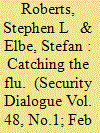

|
|
|
|
|
| Summary/Abstract |
How do algorithms shape the imaginary and practice of security? Does their proliferation point to a shift in the political rationality of security? If so, what is the nature and extent of that shift? This article argues that efforts to strengthen global health security are major drivers in the development and proliferation of new algorithmic security technologies. In response to a seeming epidemic of potentially lethal infectious disease outbreaks – including HIV/AIDS, Severe Acute Respiratory Syndrome (SARS), pandemic flu, Middle East Respiratory Syndrome (MERS), Ebola and Zika – governments and international organizations are now using several next-generation syndromic surveillance systems to rapidly detect new outbreaks globally. This article analyses the origins, design and function of three such internet-based surveillance systems: (1) the Program for Monitoring Emerging Diseases, (2) the Global Public Health Intelligence Network and (3) HealthMap. The article shows how each newly introduced system became progressively more reliant upon algorithms to mine an ever-growing volume of indirect data sources for the earliest signs of a possible new outbreak – gradually propelling algorithms into the heart of global outbreak detection. That turn to the algorithm marks a significant shift in the underlying problem, nature and role of knowledge in contemporary security policy.
|
|
|
|
|
|
|
|
|
|
|
|
|
|
|
|
| 3 |
ID:
151192


|
|
|
|
|
| Summary/Abstract |
Possibilities for crowdsourced surveillance have expanded in recent years as data uploaded to social networks can be mined, distributed, assembled, mapped, and analyzed by anyone with an uncensored internet connection. These data points are necessarily fragmented and partial, open to interpretation, and rely on algorithms for retrieval and sorting. Yet despite these limitations, they have been used to produce complex representations of space, subjects, and power relations as internet users attempt to reconstruct and investigate events while they are developing. In this article, I consider one case of crowdsourced surveillance that emerged following the detonation of two bombs at the 2013 Boston Marathon. I focus on the actions of a particular forum on reddit.com, which would exert a significant influence on the events as they unfolded. The study describes how algorithmic affordances, internet cultures, surveillance imaginaries, and visual epistemologies contributed to the structuring of thought, action, and subjectivity in the moment of the event. I use this case study as a way to examine moments of entangled political complicity and resistance, highlighting the ways in which particular surveillance practices are deployed and feed back into the event amid its unfolding.
|
|
|
|
|
|
|
|
|
|
|
|
|
|
|
|
| 4 |
ID:
176194
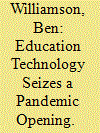

|
|
|
|
|
| Summary/Abstract |
The rapid shift to online teaching and learning during the COVID-19 pandemic has accelerated the penetration of an algorithmic world view into education systems around the world. Promoted by a burgeoning educational technology industry, platforms that use algorithms to structure and monitor teaching and learning have been presented as technical solutions to systemic problems. But they have also created new problems and reinforced existing inequities, stirring up public and political backlashes. Beyond its immediate effects during the pandemic in 2020, the expanded use of algorithm-driven learning management systems backed by major corporations has major implications for the future of global education.
|
|
|
|
|
|
|
|
|
|
|
|
|
|
|
|
| 5 |
ID:
151193
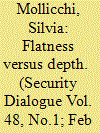

|
|
|
|
|
| Summary/Abstract |
For the past two decades, the camouflage patterns used on military uniforms have been computed by families of algorithms. The article argues that these computation methods fit within a genealogy of discourses on camouflage practices, which the text reconstructs along the axes of flatness and depth. Camouflage can be explained as an attempt at flattening information related to a target onto the underlying background, by producing general invariances within the environment and in accordance with the observer’s perceptive faculties. Carrying out this task, static camouflage responds to the aporia of using one pattern to disguise presence within multiple contexts. After analysing two discourses on camouflage in relation to the notion of flatness, the article considers a case of algorithmically generated static camouflage. Its disguising method abstracts information from both the environment in which an army is expected to fight and the observer’s perceptive capacities and then computes these threads of abstraction together in a pattern. The meshing function of computation thus flattens the principles embedded in the fabric, making them individually illegible. This changes the value that camouflage usually gives to target/background relations and to the observer’s perceptive faculties.
|
|
|
|
|
|
|
|
|
|
|
|
|
|
|
|
| 6 |
ID:
157740
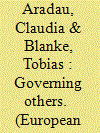

|
|
|
|
|
| Summary/Abstract |
As digital technologies and algorithmic rationalities have increasingly reconfigured security practices, critical scholars have drawn attention to their performative effects on the temporality of law, notions of rights, and understandings of subjectivity. This article proposes to explore how the ‘other’ is made knowable in massive amounts of data and how the boundary between self and other is drawn algorithmically. It argues that algorithmic security practices and Big Data technologies have transformed self/other relations. Rather than the enemy or the risky abnormal, the ‘other’ is algorithmically produced as anomaly. Although anomaly has often been used interchangeably with abnormality and pathology, a brief genealogical reading of the concept shows that it works as a supplementary term, which reconfigures the dichotomies of normality/abnormality, friend/enemy, and identity/difference. By engaging with key practices of anomaly detection by intelligence and security agencies, the article analyses the materialisation of anomalies as specific spatial ‘dots’, temporal ‘spikes’, and topological ‘nodes’. We argue that anomaly is not simply indicative of more heterogeneous modes of othering in times of Big Data, but represents a mutation in the logics of security that challenge our extant analytical and critical vocabularies.
|
|
|
|
|
|
|
|
|
|
|
|
|
|
|
|
| 7 |
ID:
102101
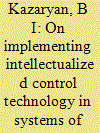

|
|
|
|
|
| Publication |
2010.
|
| Summary/Abstract |
The article defines the conditions and purposes of intellectualizing military automated control systems seen as multi-level aggregates of various complexes functioning in real time and in terms of various scales.
|
|
|
|
|
|
|
|
|
|
|
|
|
|
|
|
| 8 |
ID:
150356


|
|
|
|
|
| Summary/Abstract |
Off-grid technologies are increasingly being proposed as a way of ensuring cost efficient universal access to electricity in many developing countries. However, many un-electrified communities would prefer access to electricity via the national grid rather than off-grid technologies. Electricity planning based on cost efficiency alone could therefore be undermined by political pressure from discontented communities that are assigned off-grid technologies. Using a case study of un-electrified communities in Ghana, we develop an electricity planning algorithm based on hierarchical lexicographic programming and consider specifications where the priorities are adjusted to give weight to (1) cost efficiency and (2) political economy considerations so that communities with larger populations (and therefore votes) are given priority in terms of grid electrification. The results emphasise the need to incorporate the political economy considerations in the national planning of universal electrification, showing significant regional differences in terms of where grid extensions ought to be placed. Incorporating a political economy perspective in national planning also suggests that the most important policy trade-offs shift from considering the grid versus off-grid balance to focussing more on the effectiveness of grid investment in providing universal access.
|
|
|
|
|
|
|
|
|
|
|
|
|
|
|
|
| 9 |
ID:
151188
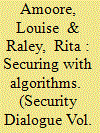

|
|
|
|
|
| Summary/Abstract |
Amid the deployment of algorithmic techniques for security – from the gathering of intelligence data to the proliferation of smart borders and predictive policing – what are the political and ethical stakes involved in securing with algorithms? Taking seriously the generative and world-making capacities of contemporary algorithms, this special issue draws attention to the embodied actions of algorithms as they extend cognition, agency and responsibility beyond the conventional sites of the human, the state and sovereignty. Though focusing on different modes of algorithmic security, each of the contributions to the special issue shares a concern with what it means to claim security on the terrain of incalculable and uncertain futures. To secure with algorithms is to reorient the embodied relation to uncertainty, so that human and non-human cognitive beings experimentally generate and learn what to bring to the surface of attention for a security action.
|
|
|
|
|
|
|
|
|
|
|
|
|
|
|
|
| 10 |
ID:
154750
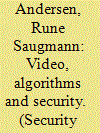

|
|
|
|
|
| Summary/Abstract |
Digital videos increasingly sustain new and older imagined communities (and enmities), and make battlefields, unfolding terror plots and emergencies public. Yet digital videos mediate security articulations following logics that are radically different from those of journalistically edited media, with consequences for how we should think of security articulation in new visual media. This article analyses how, in digital video, the combination of visible facts and the remediation logics of algorithmically governed video platforms – such as YouTube and Facebook – allow for new types of security articulations. It argues that digital video can be understood as a semiotic composite where the material semiotics of media technologies, calculated publics and spectators combines with the political semiotics of audio-visual media to condition how video articulations work as political agency. A powerful video-mediated security articulation, the #neda videos from the 2009 Iranian post-election crisis, illustrates how security articulation in digital video is not tied to the authority of a speaker and does not contain the promise of an immediate, illocutionary security effect. Drawing on securitization theory and Butler’s critique of speech act theory, this article understands such video articulations as post-sovereign security articulations.
|
|
|
|
|
|
|
|
|
|
|
|
|
|
|
|
|
|
|
|
|